1. Introduction
 XFX is a division of PINE Technologies, a leading manufacturer of state-of-the-art processing components. Founded in 1989, PINE Technology designs, develops, manufactures and distributes high-quality digital audio and video devices as well as computer peripherals. PINE also distributes branded computer and communications products. The company's movement into areas such as global B2B eCommerce and software development have helped keep it ahead of the competition. Today, PINE enjoys strategic alliances with companies such as Dell, NEC, Microsoft, Panasonic, Phillips, Ricoh, Samsung, Ingram Micro, Intel, Quantum, Connertech, Pioneer and Fujitsu.
XFX is a division of PINE Technologies, a leading manufacturer of state-of-the-art processing components. Founded in 1989, PINE Technology designs, develops, manufactures and distributes high-quality digital audio and video devices as well as computer peripherals. PINE also distributes branded computer and communications products. The company's movement into areas such as global B2B eCommerce and software development have helped keep it ahead of the competition. Today, PINE enjoys strategic alliances with companies such as Dell, NEC, Microsoft, Panasonic, Phillips, Ricoh, Samsung, Ingram Micro, Intel, Quantum, Connertech, Pioneer and Fujitsu.
After the 7800GTX series, NVidia has released a new product, the 7800GT, more affordable but maintains the high performance. XFX provided us with their GeForce 7800 GT 256MB product.

Graphics Engine |
GeForce™ 7800GT |
Video Memory |
256 MB DDR3 |
Engine Clock |
450MHz (Factory Overclock)
|
Memory Clock |
1.05GHz (Factory Overclock)
|
RAMDAC |
Dual 400MHz |
Bus Standard |
PCI-E |
Memory Bus |
256-bit |
|
32GB/sec |
Fill Rate |
|
Vertices/sec.(million) |
700 |
Pixels per clock (peak) |
20 |
TV Output |
Video-in & Video-out (VIVO) with HDTV-out support |
Adaptor/Cable bundled |
VIVO cable
2XDVI adaptors
power cord |
| Highlighted Features |
HDTV ready , Dual DVI Out , TV Out , SLI ready , DVI Out |
| System Requirements |
P4/Celeron, AMD K6/Athlon
PCI-Express 16X slot
256MB RAM at least
Installation software requires CD-ROM
DVD playback requires DVD drive
Windows 200/XP
400W minimum system power supply
(with 12V current rating of 26A) |
Chipset Features

The NVIDIA® GeForce™ 7800 GPUs supercharge gaming--delivering unparalleled performance and advanced visual effects for next-generation games. Featuring a revolutionary superscalar architecture and backed by the NVIDIA® ForceWare™ software, the GeForce™ 7800 GPUs deliver ultra-realistic effects, unmatched features, and rock-solid stability so you can play your game the way it's meant to be played. Look for special bundles at participating e-tailers.
NVIDIA® SLI™ Technology
 Delivers up to 2x the performance of a single GPU configuration for unparalleled gaming experiences by allowing two graphics cards to run in parallel. The must-have feature for performance PCI Express graphics, SLI dramatically scales performance on over 60 top PC games
Delivers up to 2x the performance of a single GPU configuration for unparalleled gaming experiences by allowing two graphics cards to run in parallel. The must-have feature for performance PCI Express graphics, SLI dramatically scales performance on over 60 top PC games
NVIDIA® PureVideo™ Technology
 The combination of high-definition video processors and NVIDIA DVD decoder software delivers unprecedented picture clarity, smooth video, accurate color, and precise image scaling for all video content to turn your PC into a high-end home theater. (Feature requires supported video software.)
The combination of high-definition video processors and NVIDIA DVD decoder software delivers unprecedented picture clarity, smooth video, accurate color, and precise image scaling for all video content to turn your PC into a high-end home theater. (Feature requires supported video software.)
PCI Express™ Support
 Designed to run perfectly with the next-generation PCI Express bus architecture. This new bus doubles the bandwidth of AGP 8X delivering over 4 GB/sec. in both upstream and downstream data transfers.
Designed to run perfectly with the next-generation PCI Express bus architecture. This new bus doubles the bandwidth of AGP 8X delivering over 4 GB/sec. in both upstream and downstream data transfers.
NVIDIA® UltraShadow™ II Technology
 Enhances the performance of bleeding-edge games, like id Software's Doom 3, that feature complex scenes with multiple light sources and objects
Enhances the performance of bleeding-edge games, like id Software's Doom 3, that feature complex scenes with multiple light sources and objects
128-bit Studio-Precision Computation
128-bit studio-precision computation through the entire pipeline prevents image defects due to low precision and ensures the best image quality for even the most demanding applications.
256-bit Memory Interface
Delivers more memory bandwidth and efficiency to power the latest games and applications at blazing speeds.
64-bit Floating Point Texture Filtering and Blending
Based on the OpenEXR technology from Industrial Light & Magic (http://www.openexr.com/), NVIDIA's 64-bit texture implementation delivers state-of-the-art high dynamic-range (HDR) visual effects through floating point capabilities in shading, filtering, texturing, and blending.
Adaptable Programmable Video Processor
PureVideo's programmable technology adapts to new video encoding formats as they are developed to provide a future-proof video solution. (Feature requires supported video software.)
Advanced Motion Adaptive De-interlacing
Smoothes video and DVD playback on progressive displays to deliver a crisp, clear picture that rivals high-end home theater systems. (Feature requires supported video software.)
Dual 400MHz RAMDACs
Blazing-fast RAMDACs support dual QXGA displays with ultra-high, ergonomic refresh rates--up to 2048x1536@85Hz.
Dual DVI Support
Able to drive the industry's largest and highest resolution flat-panel displays.
High-definition MPEG-2 and WMV Hardware Acceleration
Smoothly playback all MPEG-2 and WMV video--including WMV-HD--with minimal CPU usage so the PC is free to do other work.
Integrated HDTV Encoder
Provides world-class TV-out functionality up to 1080i resolution.
Microsoft® DirectX® 9.0 Shader Model 3.0 Support
Ensures top-notch compatibility and performance for all DirectX® 9 applications, including Shader Model 3.0 titles.
Next-generation Superscalar GPU Architecture
Delivers up to 2x the shading power of previous generation products taking gaming performance to extreme levels.
NVIDIA® CineFX™ 4.0 Engine
Delivers advanced visual effects at unimaginable speeds. Full support for Microsoft® DirectX® 9.0 Shader Model 3.0 enables stunning and complex special effects. Next-generation shader architecture with new texture unit design streamlines texture processing for faster and smoother gameplay.
NVIDIA® Digital Vibrance Control™ (DVC) 3.0 Technology
Allows the user to adjust color controls digitally to compensate for the lighting conditions of their workspace, in order to achieve accurate, bright colors in all conditions.
NVIDIA® ForceWare™ Unified Driver Architecture (UDA)
Delivers a proven record of compatibility, reliability, and stability with the widest range of games and applications. ForceWare ensures the best out-of-box experience for every user and delivers continuous performance and feature updates over the life of NVIDIA GeForce GPUs. Includes full support for PCI Express and AGP.
NVIDIA® Intellisample™ 4.0 Technology
The industry's fastest antialiasing delivers ultra-realistic visuals, with no jagged edges, at lightning-fast speeds. Visual quality is taken to new heights through a new rotated grid sampling pattern, advanced 128 Tap sample coverage, 16x anisotropic filtering, and support for transparent supersampling and multisampling.
OpenGL™ 2.0 Optimizations and Support
Ensures top-notch compatibility and performance for all OpenGL applications. NVIDIA® nView® Multi-display Advanced technology provides the ultimate in viewing flexibility and control for multiple monitors.
Video Color Correction
Color temperature correction makes actors' faces appear natural, rather than washed out and pale, when playing videos on LCD and CRT displays. Display gamma correction ensures videos are not too dark, overly bright, or washed out regardless of the video format or display. (Feature requires supported video software.)
Video Scaling and Filtering
High-quality scaling and filtering technology delivers a clear, clean image at any window size, including full-screen HDTV resolutions up to 1080i.
- Packaging/Bundle

One of the most stylish retail packages which also includes the following:
| FarCry |
| MotoGP |
| The Threat |
| NVidia drivers v77.77 |
By the time of this review, XFX suprised us by adding the brand new Call of Duty 2 game in the retail package, making it a very attractive buy for gamers that want to own the long expected Call of Duty 2 game!

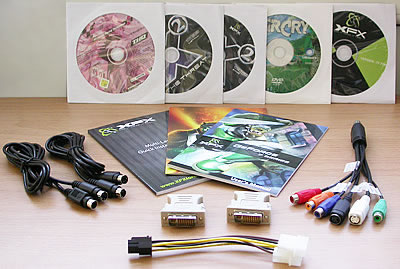
The package includes a multi-language installation guide and user's manual as well as the following cables:
- VIVO cable X1
- DVI-CRT converter X2
- Power cord X1
2. A Closer Look
As with most VGA cards in this performance range, there is an increased cooling requirement and for this reason, the largest part of the card's area is occupied by the heatsink, bearing the manufacturer's logo. According to XFX, the specific cooling system is twice as quiet and cool as the competition's.

Click on the image for a larger look
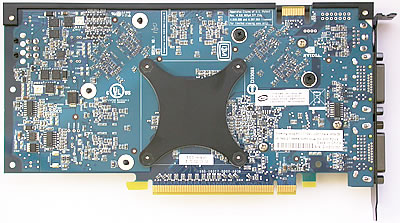
Click on the image for a larger look

The XFX 7800GT is SLI enabled, which means with a second card, it can work in SLI mode giving even higher performance.
On the top edge of the card, there is a black metal strip with the manufacturer's name on it, which lights up as soon as the system turns on.



The XFX 7800GT provides dual DVI-I connections.
Now lets move to the next page covering in detail our graphics card's testbed.
3. Test System
For our review, we used the following components:
- Processor: AMD64 3500+ NewCastle (939 socket)
- Case: Antec 1080AMG
- Motherboard: XFX A8N-SLI Deluxe
- Memory: 2x512MB Corsair XMS TWINX1024-3200XL Memory
- Hard Disk Drive: WD800JD 80GB 7200RPM
- DVD Burner: Pioneer DVR-A08XLA
- Power Supply: EzCool 550Watt
- OS: Microsoft WindowsXP Pro SP2
- DirectX: v9.0c
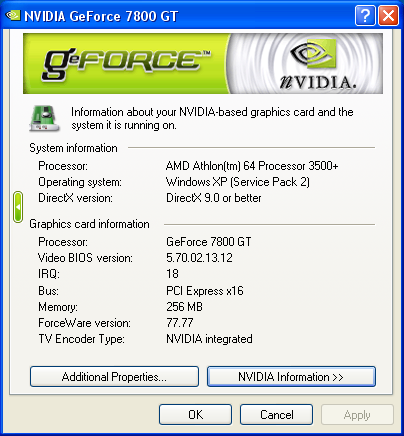
When we started our PC the temperature was close to 38 °C. After after some time, without doing anything, the temperature increased to 46 °C, which is also the most typical temperature, even while running everyday applications in Windows. During 3DMark35 or 05 benchmarks, the temperature climbed up to 66 °C, with default clock speeds of 450/1050.
| |
idle |
while benchmarks |
| Default clocks |
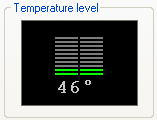 |
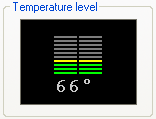 |
| Overclocked |
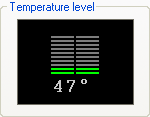 |
 |
After increasing the clock speeds to 489/1180, the system reported 47 °C with no load and 70 °C when 3DMark35 or 05 was running. The cooling system proved to be effective and silent, and as XFX declares, better that NVidia's stock, although not as effective as an NV Silencer from Arctic-Cooling.
Benchmarking Software
3DMark05,03,01
Codecreatures Benchmark Pro
AquaMark3 v3.0
RivaTuner
Farcry v1.3
HL2
Doom 3
Thief 3
Ground Control II
Colin McRae '05
For comparison reasons, we will be posting the results of the XFX 7800GT along with the ASUS N7800GTX TOP, AOpen Aeolus 6800 Ultra and Sapphire X850XT graphic cards. All cards are considered Heavy Duty, sufficient for most heavy 3D labors with high prices. It will be interesting to see the differences between the different chipsets. As we expect, the ASUS N7800GTX TOP should be the fastest and we include its performance in our graphs for reference reasons. The hottest comparison will be the one between the 7800GT, 6800Ultra and X850XT chipsets powering our XFX, AOpen and Sapphire cards respectively.

4. Advanced Features
 nVidia added Rotated Grid Multisampling in their Nv4x chipsets, increasing image and color quality in AntiAliasing modes. This new feature was introduced with the 6800 product series. Now, nVidia had to push things a little further, adding some new AntiAliasing methods. These are Gamma Correct Antialiasing and Transparency Antialiasing and are part of the technology. It is very interesting to see how the new G70 chipset performs under these antialiasing modes and if they actually make a difference in image and color quality.
nVidia added Rotated Grid Multisampling in their Nv4x chipsets, increasing image and color quality in AntiAliasing modes. This new feature was introduced with the 6800 product series. Now, nVidia had to push things a little further, adding some new AntiAliasing methods. These are Gamma Correct Antialiasing and Transparency Antialiasing and are part of the technology. It is very interesting to see how the new G70 chipset performs under these antialiasing modes and if they actually make a difference in image and color quality.
- Gamma Correct Antialiasing
Gamma-adjusted rotated-grid antialiasing removes jagged edges, promising incredible image quality. You will find the option to enable Gamma Correct Antialiasing under the "performance and quality settings" tab. You should select the "advanced settings", and there it is:

In order to check the quality improvement you can gain with this new feature, we used Far Cry and HL2. Below you can see the results we got. Clicking on the images will reveal a higher resolution image:
Far Cry - Gamma Correction |
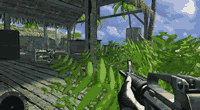 |
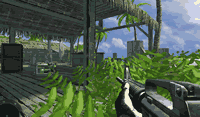 |
| NoAA |
8x AA / Gamma Correction |
| HL2 - Gamma Correction |
 |
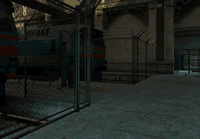 |
| NoAA |
8x AA / Gamma Correction |
As you can see, differences can be easily seen on vegetation, smoothing the edges of leaves. In HL2, you will notice that the fence seems more realistic. Differences in lighting effects have to do with simple AntiAliasing and not with Gamma corrected antialiasing.
- Transparency Antialiasing
Both new antialiasing modes—transparency adaptive supersampling and transparency adaptive multisampling—are ideal for outdoor environments, scenes with vegetation, chain link fences, and any situation where the models are seen as very thin from the angle of viewing. The graphics processor will take additional texel samples and antialiasing passes to enhance the quality of thin-lined objects. According to nVidia: Transparency adaptive multisampling also improves antialiasing quality—with even higher levels of performance because one texel sample is used to calculate surrounding subpixel values. Although transparency adaptive multisampling is not as high quality as the supersampling method, its increased efficiency balances improved image quality and high levels of performance. The visual improvements of adaptive supersampling are obvious when compared to generic supersampling/multisampling approaches.
Again, the settings to change Transparency Antialiasing are hidden in the "performance and quality settings" tab.

Below you can see the results we got with FarCry and HL2. Again, clicking on an image will open a larger picture:
| Far Cry - Transparency Antialiasing modes |
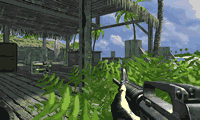 |
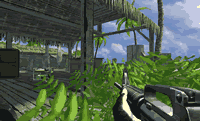 |
| MultiSampling |
SuperSampling |
| HL2 - Transparency Antialiasing modes |
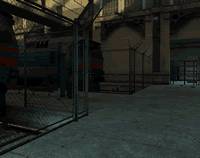 |
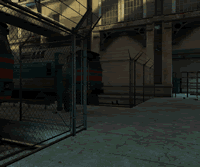 |
| MultiSampling |
SuperSampling |
As you can see, there is a major boost in image quality. Fences and vegetation are generally rendered on very simple polygon models. However, Transparency antialiasing makes a step forward in image quality.
Someone might say that these new antialiasing modes might reduce the performance of the graphics card. nVidia proved this statement wrong. We were amazed to see that there is no significant difference between 4xAA, 8xAA and Supersampling Transparency AA.
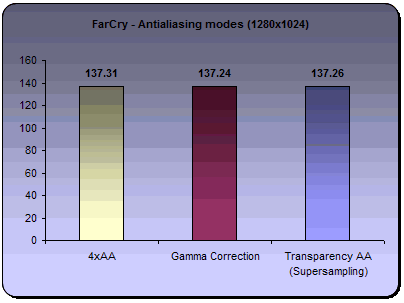
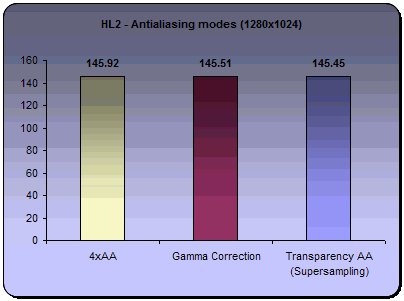
There is, however, a known bug with the latest 78.01 and 77.77 graphics drivers that makes fences disappear under certain circumstances. nVidia will look into this issue and release a new device driver soon, correcting this problem.
5. 3DMark05
 With 3DMark05, Futuremark continues the tradition in its benchmarking software by providing a state-of-the-art Microsoft ® DirectX ® 9 3D performance benchmark.
With 3DMark05, Futuremark continues the tradition in its benchmarking software by providing a state-of-the-art Microsoft ® DirectX ® 9 3D performance benchmark.
3DMark05 is an all new 3DMark version making the most of Microsoft's DirectX
9. The previous version 3DMark03, did a nice introduction into this level
of technology. However
3DMark03 used DirectX 9 specific features in a limited manner, because fully
supporting hardware was rare at the time of its launch. In contrast, 3DMark05
requires DirectX 9 hardware with full support for at least Shader Model 2,
and takes shader usage to never before seen levels.
Just like its predecessors, 3DMark05's point system is set so that at the
moment of release, the high-end VGA cards available in stores can only score
around 5000 3DMarks, whereas the worst card that meets the programs requirements
yields a score of 1000.
Game Test 1 -Return to Proxycon
 Being the sequel to the "Battle of Proxycon"
from 3DMark03, in "Return to Proxycon" we're once again set in space
and the battle continues as space pirates invade a cargo ship in order to
take control of its valuable cargo.
Being the sequel to the "Battle of Proxycon"
from 3DMark03, in "Return to Proxycon" we're once again set in space
and the battle continues as space pirates invade a cargo ship in order to
take control of its valuable cargo.
This test, tries to simulate a future first-person shooter game with all the high details that entails. The dynamic shadows, high-detailed environment and advanced lighting techniques ensure that under normal circumstances, no recent card can run it with decent frame rates.
Game Test 2 - Firefly Forest
 A forest gets filled with magic fireflies in the night. The moon is nearly full, illuminating the forest with a bluish faint light. The magic fireflies have flickering bright green lights that playfully move around the forest.
A forest gets filled with magic fireflies in the night. The moon is nearly full, illuminating the forest with a bluish faint light. The magic fireflies have flickering bright green lights that playfully move around the forest.
This scene is a nice example of a smaller scale outdoor scene with rich vegetation. Immediate visibility is not so far, and there is a skybox surrounding the whole scene.
A large number of trees with their branches swinging separately, and dense vegetation being dynamically distributed according to the camera movements, make this test the most demanding of the three.
Game Test 3 - Canyon Flight
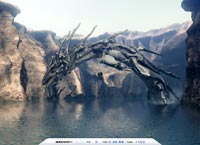 A Jules Verne type airship flies through a canyon guarded
by a dangerous sea monster. The airmen defend their ship using heavy cannons,
but these seem to have no effect on the huge sea monster. Finally the crew
manages a narrow escape using the "last resort" afterburners of
the airship.
A Jules Verne type airship flies through a canyon guarded
by a dangerous sea monster. The airmen defend their ship using heavy cannons,
but these seem to have no effect on the huge sea monster. Finally the crew
manages a narrow escape using the "last resort" afterburners of
the airship.
This scene is fairly complex with large areas of water
reflecting the high canyon walls. The water actually is one of the key points
of interest in this scene. The water not only does realistic looking reflections
and refractions, it has a depth fog, making the sea monster swimming under
the airship actually look deep down in the water. The air in this scene also
uses a volumetric fog, making distant cliffs of the canyon really look far
away.

According to 3DMark05, the performance of the XFX 7800GT is lower than that of the ASUS N7800GTX TOP, something we expected, and faster than the AOpen Aeolus 6800Ultra and Sapphire X850XT. It is rather interesting to see that the new 7800GT has faster framerates in all three tests, than an 6800Ultra or a X850XT card.
Final Score
3DMarks on 3DMark05 are now calculated by the following formula:
(Game Test 1 * Game Test 2 * Game Test 3)^0.33 * 250
That's basically the geometric mean of the total frames in each
game multiplied by 250. This means that all game tests are now equal.

As we expected and from the previous test's framerates, the highest total 3DMark05 score reported came from the ASUS card. XFX was placed in second position, way in front of the AOpen and Sapphire cards. The 7142 3DMarks for the XFX is a very good score and leaves behind by a thousand 3DMarks, the 6800Ultra and the X850XT cards.
6. 3DMark03
 3D Mark is a widely used and accepted benchmark that stresses the DirectX performance of a VGA card. A very strong point of 3DMark is that it's VGA card measuring does not require any CPU power. So the resulting fps are a good reference a VGA card's rendering performance. For testing the performance of each card we used the 4 game benchmarks 3DMark has.
3D Mark is a widely used and accepted benchmark that stresses the DirectX performance of a VGA card. A very strong point of 3DMark is that it's VGA card measuring does not require any CPU power. So the resulting fps are a good reference a VGA card's rendering performance. For testing the performance of each card we used the 4 game benchmarks 3DMark has.
3Dmark03 also includes sound and CPU tests as well as some other feature tests.
- Game Test 1 - Wings of Fury (DX7)

This test is a combat flight simulator written for older hardware (DirectX 7). Particles are used a lot in this test - smoke and vapor trails, flak and gunfire, and explosions are produced using point sprites and quads.
- Game Test 2 - Battle of Proxycon (DX8)

This test is a simulation of first person shooter game types. 1.1 and 1.4 Vertex shaders are widely used since all character models are skinned using vertex shaders.This makes this test a good vertex shader comparison for VGA cards.
- Game Test 3 - Trolls' Lair (DX8)
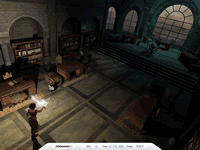
This test should be the favorite of all RPG lovers. It is a cut scene of a female warrior facing two malicious trolls. Again the same vertex and pixel processing is used as in game test 2.
This test also uses post-processing effects, such as Depth of Field and Bloom effects which are widely used in today's game cut scene sequences.
- Game Test 4 - Mother Nature (DX9)
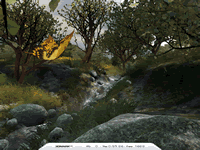
Mother nature represents the level of effects and realism that are possible using 2.0 vertex and pixel shaders, plus some other features that DirectX 9 offers.
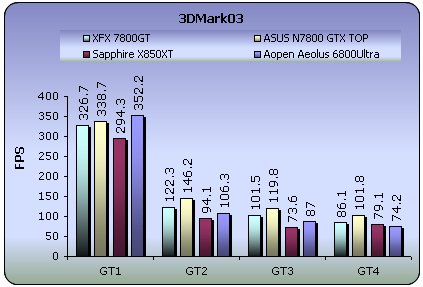
In the first game, the 6800Ultra reported a higher framerate than the 7800GT, or even the 7800GTX, while the X850 was far behind. The scene totally changed with the following test games. The new GeForce 7 series managed to leave behind the previous generation 6800 and X850XT. Very good performance from the XFX.
- 3DMark Official score
If you test your machine with 3DMark, you can post the results at 3DMark's online result browser. For more information visit futuremark.com.
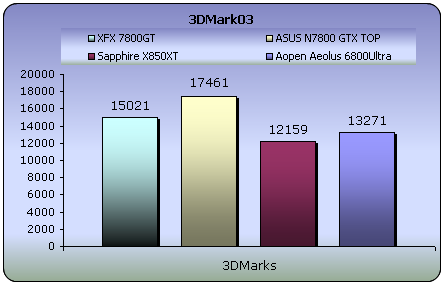
Once again, the total score for the XFX 7800GT is much higher than that from AOpen and Sapphire.
7. Codecreatures
 CodeCreatures is a synthetic 3D benchmark that is a good reference for VGA performance comparison. This is a high-end 3D benchmark that also requires DirectX 8 hardware, making a good tool for measuring the potential of DirectX 8 game performance.
CodeCreatures is a synthetic 3D benchmark that is a good reference for VGA performance comparison. This is a high-end 3D benchmark that also requires DirectX 8 hardware, making a good tool for measuring the potential of DirectX 8 game performance.
The Codecreatures benchmark is written with Microsoft's DirectX 8.1 API and incorporates the use of Vertex and PixelShaders popular on next generation 3D accelerators.

The benchmark plays a photo-realistic nature scene and calculates the performance of the graphics adapter by measuring the fps that it can display at 1024x768, 1280x1024 and 1600x1200 resolutions.
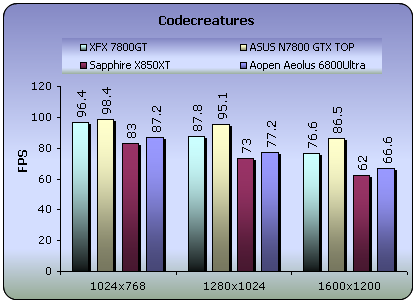
-Codecreatures number
The codecreatures number is the resulting score of the total
benchmarking process and is basically the geometric mean of the three frame
rates multiplied by 100.
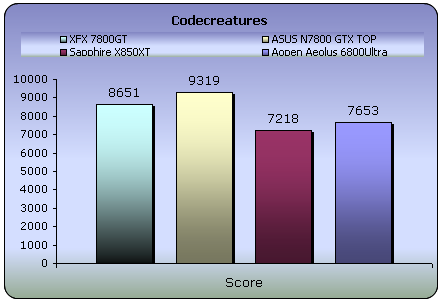
The 7800 series cards are placed in the first positions. ASUS is always the fastest with XFX following. As we previously stated, this is something we expected and the most interesting comparison is with the other participating cards.
8. Aquamark/3DMark 2001
 Since the majority of today's applications and games are compatible with DirectX 9, the need of benchmark applications that use DX 9 has been brought up. The benchmark uses the 3D engine (Krass engine) of the Aquanox game.
Since the majority of today's applications and games are compatible with DirectX 9, the need of benchmark applications that use DX 9 has been brought up. The benchmark uses the 3D engine (Krass engine) of the Aquanox game.
- Aquamark Triscore
The Aquamark Triscore comprises 3 values: the overall system performance, the performance of the graphics system and the CPU performance. Keep in mind that this is not the total result of the tests, but the result of the whole benchmark process including all 9 chapters.
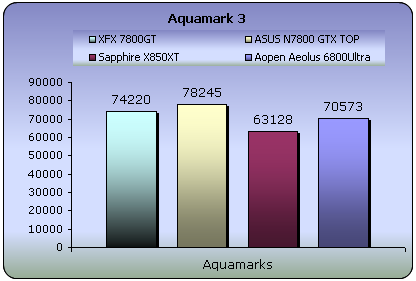
The scene is still the same. ASUS and XFX in the first two positions. The most recent generation chipsets are much improved over the older 6800 and X850.
- 3DMark 2001
 is the predecessor to 3DMark03. It's mainly a directx8.1 benchmark and the score depends a lot on the CPU power of your computer. However for reference use only we decided it'd be best to just leave it in our benchmark list so you can compare the next generation cards with the possibly outdated you have at home.
is the predecessor to 3DMark03. It's mainly a directx8.1 benchmark and the score depends a lot on the CPU power of your computer. However for reference use only we decided it'd be best to just leave it in our benchmark list so you can compare the next generation cards with the possibly outdated you have at home.
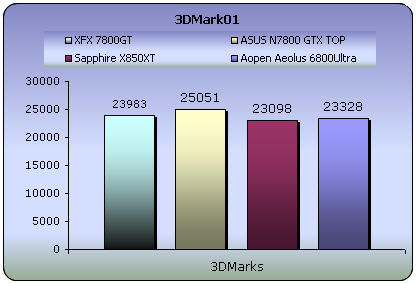
This is the first test where we see the 6800Ultra from AOpen and the X850XT from Sapphire reaching so close to the XFX 7800GT. The XFX is still better, but this time not by much. We believe this benchmark is too old, to be able to capitalise on the real power of the new 7800 cards.
9. Half Life 2
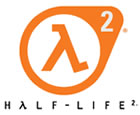
Half life 2 is no doubt the most anticipated pc game of all times. Gamers keeping the excellence of Half Life 1 in their mind as well as the remarkable E3 demo preview, have been anxiously waiting for the much delayed release of HL2.
 Characters - Advanced facial animation system delivers the most sophisticated in-game characters ever seen. With 40 distinct facial "muscles," human characters convey the full array of human emotion, and respond to the player with fluidity and intelligence.
Characters - Advanced facial animation system delivers the most sophisticated in-game characters ever seen. With 40 distinct facial "muscles," human characters convey the full array of human emotion, and respond to the player with fluidity and intelligence.
Physics - From pebbles to water to 2-ton trucks respond as expected, as they obey the laws of mass, friction, gravity, and buoyancy.
 Graphics
- Source's shader-based renderer, like the one used at Pixar to create movies
such as Toy Story® and Monster's, Inc.®, creates the most beautiful
and realistic environments ever seen in a video game.
Graphics
- Source's shader-based renderer, like the one used at Pixar to create movies
such as Toy Story® and Monster's, Inc.®, creates the most beautiful
and realistic environments ever seen in a video game.
AI - Neither friends nor enemies charge blindly into the fray. They can assess threats, navigate tricky terrain, and fashion weapons from whatever is at hand.
To measure performance we used the Video Stress Test(VST) that is available in the CounterStrike:Source beta available through Steam. We set all the details to the highest level and each time changed the resolution from 800x600 up to 1600x1200.
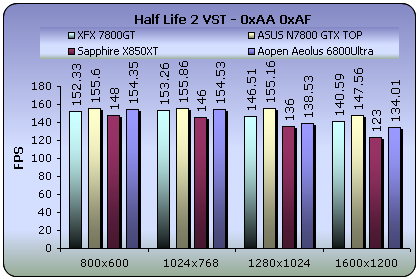
With AA and AF settings off, all cards reported extremely high framerates, with ASUS of course being the fastest, while the XFX 7800GT is better than the AOpen and Sapphire at the higher resolutions.

With AA and AF set at 4X and 8X respectively, the scene clears up about who's the best. 135fps at 1600X1200 is quite impressive from the ASUS, as is also the 119fps from the XFX.
10. Doom 3

A massive demonic invasion has overwhelmed the Union Aerospace Corporations? (UAC) Mars Research Facility leaving only chaos and horror in its wake. As one of the few survivors, you struggle with shock and fear as you fight your way to Hell and back, in an epic clash against pure evil.
Activision made it's miracle again with Doom 3 which is said to be the best-looking game ever, thanks to the brand-new OpenGL graphics engine used to generate its convincingly lifelike, densely atmospheric, and surprisingly expansive environments. If you are a fan of the previous Doom games then you will get many flashbacks with this revision, since you will find reimagined versions of almost every monster from both Doom and Doom II.

To measure performance on the game we used the timedemo demo1 command from the console (Alt+Ctrl+~).
Enabling the high quality setting and executing the timedemo demo1 command twice for each resolution, we witnessed the following:
First, without the Anti-Aliasing and Anisotropic Filtering settings
enabled, we got the following results:
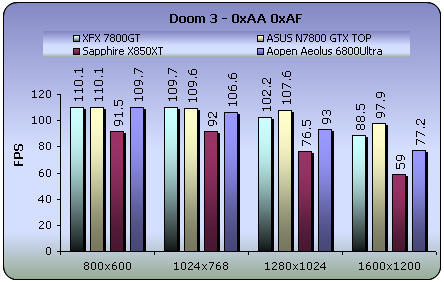
As the introductory logo display informs us while launching Doom3, Nvidia based cards perform better with this specific test. Notice the fps differences between the NVidia cards and the X850. At 1600X1200, the XFX reported 11fps more than the AOpen card.

With filtering enabled, at lower resolutions, the NVidia chipset based cards reported similar performance. We are pretty sure that you won't buy such an expensive card, just to play your favourite games at 800X600. So we moved straight to to higher resolutions of 1280X1024 and 1600X1200. The ASUS is always ahead but we are mostly interested in the XFX's performance in comparison with the AOpen's and Sapphire's. The XFX is 5fps faster than the AOpen at 1280X1024 and 18fps than the Sapphire, while at 1600X1200 only 5fps than the Aopen, but still faster, and 17fps than the Sapphire.
11. FarCry

 You are Jack Carver running your own boat charter business in beautiful Micronesia. With a past best left behind you, you'll be focusing on your present assignment: escorting an ambitious journalist named Valerie Cortez to the Island of Cabatu. It seems like a piece of cake, but you'll soon learn: paradise can be hell.
You are Jack Carver running your own boat charter business in beautiful Micronesia. With a past best left behind you, you'll be focusing on your present assignment: escorting an ambitious journalist named Valerie Cortez to the Island of Cabatu. It seems like a piece of cake, but you'll soon learn: paradise can be hell.
Farcry is an awesome First Person Shooter (FPS) based on a last generation 3D engine named as CryEngine. Real-time editing, bump-mapping, static lights, network system, integrated physics system, shaders, shadows and a dynamic music system are just some of the state of-the-art features that the CryEngine offers.
A great advantage and strong point of the CryEngine is its physics system which supports character inverse kinematics, vehicles, rigid bodies, liquid, rag doll, cloth and body effects. All physics seem to be very realistic and you never get bored when facing enemies, since character models have multiple animations that blend in believable ways.
With an integrated shader system and a massive terrain which maximizes
the view distance to 2km, these features make Farcry a perfect action game and
also a referable benchmark to speak of.
- Benchmark Settings
For this game we recorded a custom demo from the start of the Rebellion
stage. We chose an indoor scene in order to avoid getting the CPU bound effect. This will result in slightly higher results since it is also less
GPU intensive, but we can't afford being stuck at 40-50 fps because of our CPU.
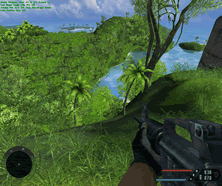
The latest patch (1.3) was used for our tests which updates the
game's graphics engine to use the 3.0 Shader model. This option is only supported
for the 6800 series.

The resolutions we ran the demo under, are the following: 800X600, 1024X768, 1280X1024 and 1600X1200.
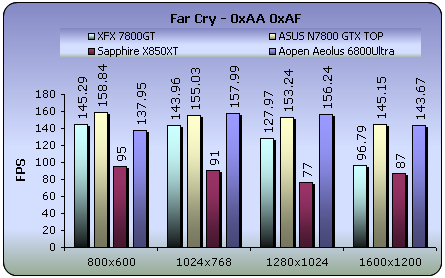
Once again, the game seems to like mostly the NVidia chipsets. Same performance for the 6800Ultra and 7800GTX. This time however, the 7800GT reported low framerates.
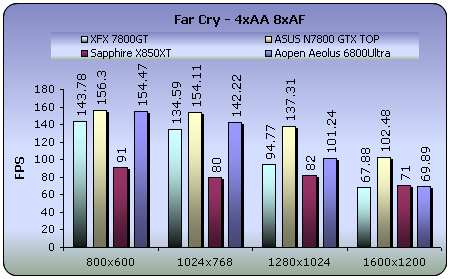
It seems that FryCry is the only game where the 7800GT has similar performance to the 6800Ultra and X850XT.
12. Thief 3
 Instead
of Deus Ex from now on we'll be testing our cards using Thief 3. It's based
on the same engine but it's much less GPU intensive and playable by more VGA
cards than
Instead
of Deus Ex from now on we'll be testing our cards using Thief 3. It's based
on the same engine but it's much less GPU intensive and playable by more VGA
cards than  Deus.
Deus.
The game makes severe use of Pixel Shader 1.1 instructions, the bloom effect and stencil shadows to achieve a wonderful result in your screen.
In the game you play the part of Master Thief Garrett who is back to rule out any evil forces using his unique stealth abilities. Deadly Shadows shows what stealth gameplay is all about. This game really gives you the feel of sneaking around and holding your breath when stuck in a sticky situation.
Since there is no official benchmark for the game, we'll do our tests using
a GPU intensive scene from the tutorial-level which we believe that represents
the average fps you'll get when playing the game.
Thief 3 is a torture test for graphics cards. All lower class cards fail to provide stable performance in this benchmark when selecting full details from the settings menu.
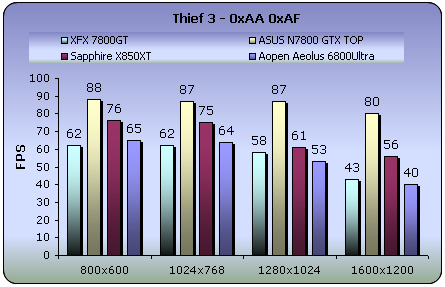
If you have the Animalising and Anisitropic Filtering disabled, the ASUS will provide the same performance, no matter what the resolution, while the X850XT is faster than the 7800GT and 6800Ultra.
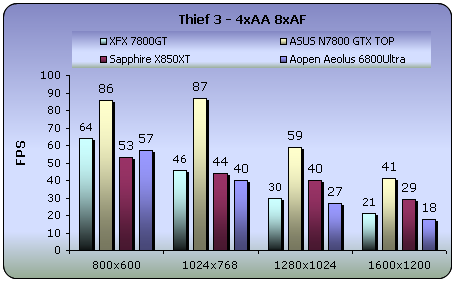
The overall performance is the same as with filtering enabled, but this time with half the framerates. Still, ASUS is the fastest with Sapphire following.
13. Colin McRae 2005
 For all you racing fans out there, this test is for you and will represent the Racing game category in our benchmarks.
For all you racing fans out there, this test is for you and will represent the Racing game category in our benchmarks.
From the graphics point of view the first thing you'll
notice in the game is the excellent amount detail of your racing car. High
resolution textures on the car and lighting make it quite impressive. All
the eye candy such as the sun reflection in the virtual camera are still the
same as the older CM versions but motion blur has been added when your card
hits something hard which will happen most often if you're new to the racing
simulation world.
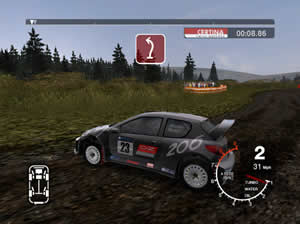
To measure performance on the game we used fraps to get the average fps of the whole 8th stage of UK which is actually the only stage you get to play on the demo.
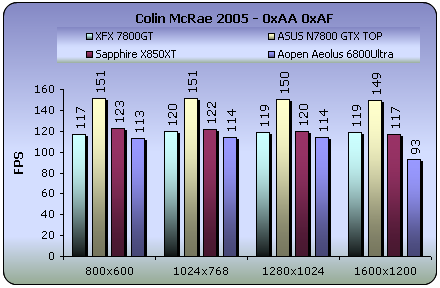
The XFX 7800GT reported similar performance to Sapphire's X850XT and rather better than AOpen's 6800Ultra.
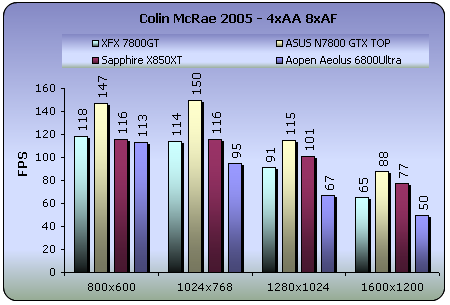
By enabling AA and AF to increase image quality, the XFX 7800GT goes from second place to third, since the X850XT is much better by 12fps.
14. Ground Control II
 Ground
Control 2 is an action-oriented game of tactics and warfare. As Captain Jacob
Angelus of the Northern Star Alliance, you will command squads of infantry,
artillery, and air power against the might of the Empire of Terra. Base building
and resource-collecting are replaced with unit control and combat tactics where
your knowledge of the battlefield maneuvers will make the difference in your
fight against a ruthless enemy. Position your troops on hilltops for better
aim or inside buildings and forests for protection as you'll need to use every
inch of terrain to your advantage.
Ground
Control 2 is an action-oriented game of tactics and warfare. As Captain Jacob
Angelus of the Northern Star Alliance, you will command squads of infantry,
artillery, and air power against the might of the Empire of Terra. Base building
and resource-collecting are replaced with unit control and combat tactics where
your knowledge of the battlefield maneuvers will make the difference in your
fight against a ruthless enemy. Position your troops on hilltops for better
aim or inside buildings and forests for protection as you'll need to use every
inch of terrain to your advantage.
For our benchmarks, we used the highest possible settings on the first mission
of the single player game and moved around the camera to get an average frame
rate using fraps.

Ground Control II offers really impressive graphics without requiring much GPU power. Click on the picture above to view a screenshot from the game. Check out these excellent water effects!

Similar performance from the 7800GT and 7800GTX. Notice that the 7800GT reported slightly higher framerates at resolutions up to 1280X1024. Much lower performance from the X850XT and 6800Ultra.
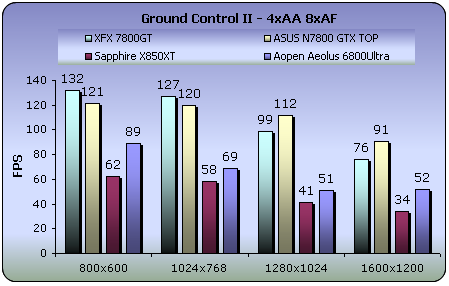
With AA and AF enabled, the situation is similar to the previous with filtering disabled. At lower resolutions, the XFX card is the fastest while at higher, the ASUS.
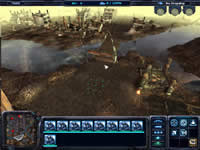
15. Overclocking
No matter your graphics card, there comes a time in your computer's life when it can no longer cope with the latest technology the ever so popular games use. This is one of the main reasons for overclocking your graphics card. Gamers are always looking forward for a little extra boost in terms of framerate. Even though most of the times the boost is far from noticeable, overclocking remains the last resort when you can't afford to buy a brand new VGA card.
 |
Increasing the memory clock too much,
produces the so-called "artifacts". |
The stock clock speeds for the XFX 7800GT are 450MHz for the GPU and 1.35GHz for the memory modules. Notice that the default clock speeds for NVidia's 7800GT chipset are 400MHz and 1.0GHz for for the GPU and the memory modules respectively. So knowing that the XFX 7800GT is already overclocked, we're not expecting a lot.

With the contribution of RivaTuner we managed to set the core clock to 489MHz and the memory clock frequency to 1.18GHz, not a negligible difference, while the already overclocked XFX 7800GT has gone even higher. It seems that XFX has chosen not to reach the limits of the card, opting for higher stability and reliability.

As we mentioned in a previous page, the cooling system is rather good, able to handle the higher clock frequencies.
| |
idle |
while benchmarks |
| Default clocks |
 |
 |
| Overclocked |
 |
 |
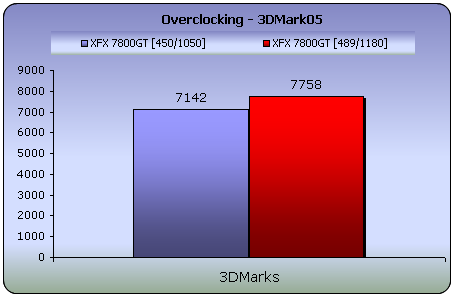
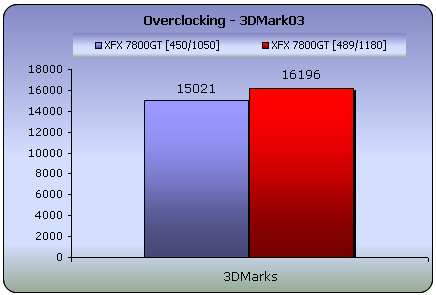
With benchmarks such as Futuremark's 3DM03 and 3DM05 there is a rather good difference between the default and our overclocked settings. 600 3DMarks in 3DM05 and 1000 3DMarks in 3DM03 is a very good performance. We also tried with even higher clocks, for example 509/1245 or 500/1230, but either the 3DM05 or 3DM03 were froze so we had to find a more stable settings. At 489/1180 the XFX 7800GT finished the tests without a single problem.
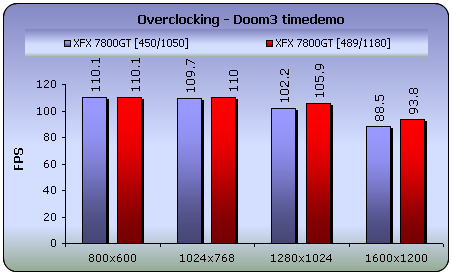
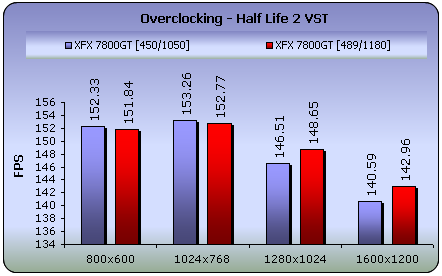
In real world, where games is the judge, the overclocked settings reported negligible difference than the stock settings. Moreover in HL2 sometimes there were artifacts reported. You might gain 2~5fps in higher resolutions with filtering disabled while 5~8fps with AA and AF enabled ( in HL2 at 1600X1200 with 4XAA and 8XA the framerate is 127.7fps instead of 119fps while in Doom3 55.9fps instead 50.5fps). Such difference we believe is not a reason for further overclock of the XFX 7800GT.
16. Conclusion
The XFX 7800GT is a very good card, with a great design and high quality. Its stock cooling system differs from NVidia's default cooler for 7800GT cards, which according to our tests seems to be more efficient at keeping the temperatures low, approximately 46°C at idle and 66°C while running 3DMark05. With NVidia's stock cooling system, the temperatures are approximately 50°C and 65°C for idle and 3DMark05 load respectively. The best thing here is that even when we increased the clock frequencies for the GPU and memory, the temperature didn't increase by much, only 47 °C for idle and 70°C with 3DMark05.
The retail package is great and includes two DVI to VGA adapters, one VIVO and one power cable. What we mostly liked is the presence of the FarCry game in the software bundle. Even better, by the time this review was written, XFX decided to offer the brand new long expected Call of Duty 2 game in the retail package, making it the most attractive buy, concerning bundled games. Not many cards include such games so we believe the unique design of the retail box along with everything it includes, deserves our 5 stars ranking.


The XFX 7800GT reported good overall performance with all tests, in most cases much better than the X850XT or 6800Ultra, but not as good as the 7800GTX. In other words, there is no game that you cannot play at high resolutions and with AA and AF enabled. The reported 119fps in HL2, the 50fps in Doom 3, the 67.8fps in FarCry, the 65fps in Colin McRae etc., at 1600X1200 with 4XAA and 8XAF confirm this.
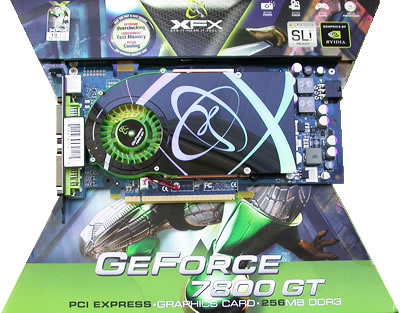
The XFX 7800GT comes with higher clock frequencies from the manufacturer, 450MHz for the Core Clock Frequency and 1.05GHz for the Memory Clock Frequency instead of the default 400MHz and 1.0GHz than a normal 7800GT has. There is still the ability to go higher, as we did, but don't expect too much improvement, especially in games. Although at 489/1180, 3DMark scores were higher, 600 3DMarks in 3DM05 and 1000 3DMarks in 3DM03, in games however, the best you can get is 2~5fps with AA and AF disabled and 5~8fps with AA and AF enabled. Moreover, with the clocks set so high, we got artifacts in HL2 although in Doom 3, 3DMark03 and 05 there were no problems. So, we believe any overclocking will only reduce the stability and therefore isn't recommended.
Performance was rather good but what about the price? At the time of this review, the price of the overclocked XFX 7800GT was US$375 at newegg.com. At the same time, the Sapphire X850XT PE costs US$399 and the AOpen 6800Ultra up to US$465. Just for comparison, a 7800GTX from XFX costs US$468 while the great ASUS N7800GTX TOP, US$579. With such prices, we highly believe that the XFX 7800GT is an excellent purchase that combines high performance at an affordable price.
Pros:
- Good performance in all tests
- Good cooling system
- Low noise levels
- Great nVidia features for unique image quality
- Very good retail package
- Reasonable price for such performance
Cons:
- Priced on the high side

Performance: |
|
Overclocking: |
|
Bundle: |
|
Value for money: |
|